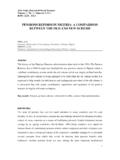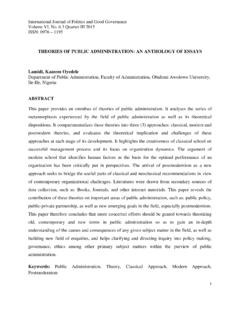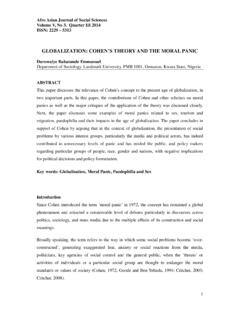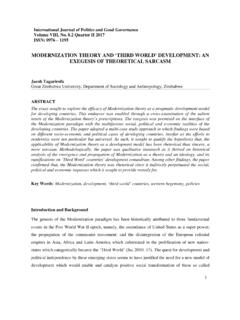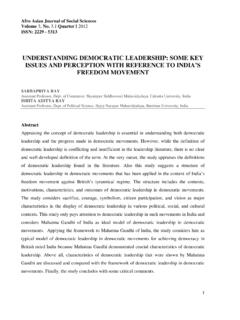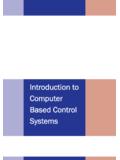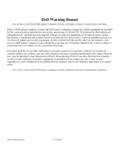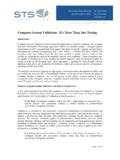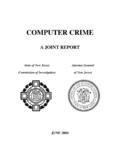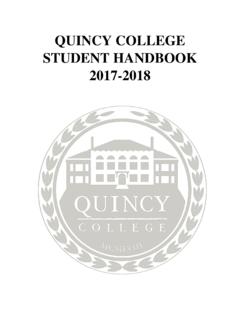Transcription of Impact of Employee Turnover on Sustainable Growth of ...
1 Afro Asian Journal of Social Sciences Volume 2, No. Quarter IV 2011. ISSN 2229 - 5313. Impact of Employee Turnover on Sustainable Growth of Organization in Computer Graphics Sector of Karachi, Pakistan Fahad Abdali Director, South Asian Resources Group, Karachi Pakistan Abstract The overall purpose of this study was to find out the effect of Employee Turnover on Sustainable Growth of organization in computer graphics sector of Karachi, Pakistan. This study specifically finds out the main causes and ground realities of the problem of Employee Turnover on Sustainable Growth of organization.
2 The study could be of help in reviewing the relevant policies of similar organizations with regard to their human resources. Keywords: Employee Turnover , organizational performance, Impact of Employee Turnover , Sustainable Growth . Introduction The term Turnover is defined by Price (1977) as: The ratio of the employees of organization who left in a particular period of time with the average number of employees in that organization during the same period of time . According to Currivan (1999), Turnover is a behavior which describes the process of leaving or replacing employees in an organization.
3 Agnes (1999) defined Turnover as It is the ratio of number of workers that had to be replaced in a given time period to the average numbers of workers . 1. Afro Asian Journal of Social Sciences Volume 2, No. Quarter IV 2011. ISSN 2229 - 5313. Turnover has considerable Impact on an organization performance as it should be properly addressed and measured. In a survey conducted by Chartered Institute of Personnel and Development (CIPD) in 2005, different responses towards Turnover were revealed as follows: - 52 % of the respondents felt that labor Turnover had a minor negative effect on organizational performance.
4 - 21 % stated that there was no effect. - 17 % stated that a serious negative effect. - And 9 % that there was a positive effect. Past researches concluded that Employee Turnover has very negative effect on the operating performance of an organization with the help of theoretical and empirical analysis and this is due to interruption of daily organizational routines (Dalton and Todor 1979, Bluedorn 1982). On the other hand, many other researchers found that organization gets benefit due to fresh blood and innovative thinking and also increases the motivational level of employees that bring to a new job (Abelson and Baysinger 1984, Mowday et al.)
5 1982). Literature review and hypotheses Employee Turnover may be classified into five categories a) Functional Vs Dysfunctional Turnover : Functional Turnover can be defined as A Turnover in which poor performers leave while Dysfunctional Turnover can be defined as A Turnover in which good performers leave (cited in Wikipedia). b) Avoidable Vs Unavoidable Turnover : A Turnover that happens in avoidable circumstances is called Avoidable Turnover ', where as A. Turnover that happens in unavoidable circumstances is called Unavoidable Turnover ' (cited in Wikipedia).
6 2. Afro Asian Journal of Social Sciences Volume 2, No. Quarter IV 2011. ISSN 2229 - 5313. c) Voluntary v/s Involuntary Turnover : Voluntary Turnover can be defined as The Turnover in which Employee has own choice to quit or instances of Turnover initiated at the choice of employees where involuntary Turnover can be defined as The Turnover in which employees have no choice in their termination sickness, death, moving abroad or employer's initiated termination (cited in Wikipedia). d) Internal Vs External Turnover : Turnover can be classified as internal Turnover ' or external Turnover ' (cited in Wikipedia).
7 Internal Turnover happens when employees send-off their current position and getting a new position within the same organization. It is related with the internal recruitment where organizations filling the vacant position by their Employee or recruiting within the organization. e) Skilled Vs Unskilled Turnover Untrained, uneducated and unskilled positions often face high Turnover rate. Without the organization or business incurring any loss of performance, employees can generally be replaced. On the other hand skilled and educated positions may create a risk to the organization while leaving.
8 Therefore Turnover for skilled and educated professionals incur replacement costs as well as competitive disadvantage of the business. THEORIES OF Employee Turnover . During the past several years, researchers have committed extra ordinary efforts in finding the fact regarding the reasons why employees leave their job. The total 12 theories of Employee Turnover are as follows: a) March and Simon: Theory of Organization Equilibrium (1958). b) Porter and Steers: Met Expectation Model (1973). c) Mobley: Turnover Process Model (1977). d) Hom and Griffeth: Revised Intermediate - Process Model (1984).
9 E) Price: Structural Model (1977). f) Mobley, Griffeth, Hand and Meglino: Expanded Model (1979). 3. Afro Asian Journal of Social Sciences Volume 2, No. Quarter IV 2011. ISSN 2229 - 5313. g) Muchinsky and Morrow: Multidisciplinary Model (1980). h) Ferrell and Rusbult: Investment Model (1981). i) Steers and Mowday: Multi - Route Model (1981). J) Sheridan and Abelson: Cusp Catastrophe Model (1983). k) Hulin, Roznowski and Hachiya: Labor Economic Model (1985). l) Lee and Mitchell: Unfolding Model (1994). MAJOR CAUSES OF Employee Turnover . The Employee Turnover may be caused by: 1) Demographic and Personal Characteristics of an Employee The demographic and personnel characteristics of an Employee may be reason of leaving from the organization.
10 These characteristics are age, gender, qualification, marital status, experience and tenure. Different researches proved different demographic characteristics for reason of leaving. According to Hom and Griffeth (1995), women did not quit their jobs more freely than did men;. rather they were more loyal employees. Kinship association and number of children improved Turnover while the number of relatives in the community increase organizational exits. Older employees who have long stay in the company depart unusually than younger and short tenure employees.
